Exclusive: Justice for victim’s severe injuries is elusive after he was shot point-blank by police on Jan. 6

Mark Griffin was trying to caution police at the U.S. Capitol on Jan. 6 against firing more rubber pellets and explosive munitions into the massive crowd when a police sergeant shouldered a munition launcher and shot Griffin in the left leg with 40mm hard-rubber baton rounds.
The point-blank blast likely from Metropolitan Police Department Sgt. Frank Edwards came seconds after Griffin explained he hadn’t touched the bicycle-rack barrier on the West Plaza as Edwards claimed. “Calm down,” Griffin said.
'You’ve got a video that shows him deliberately, from three feet away, "Bang!"'
The officer lowered the weapon slightly, video showed, and shot Griffin. “What are you doing?” the officer spouted. He popped the smoking empty shell out of the barrel and hustled off to reload.
Griffin was in blinding pain. As he bent over in shock, video showed, Griffin was blasted in the face with pepper spray by an MPD officer who reached over the barricade to deliver insult to injury.
Griffin hobbled away with what he later discovered was a massive break of his left femur. The injury cost him nearly a year in recovery.
Griffin long suspected that Sgt. Edwards was the one who shot him. A Blaze News investigation of video appeared to confirm this in late 2024.
Bodycam evidence strongly suggested that Sgt. Edwards fired the shot, but no publicly available video was conclusive. A U.S. Department of Justice trial exhibit — overhead video shot by a journalist — later showed clearly that Edwards most likely was the trigger man.
Just seconds earlier, MPD Inspector Robert Glover — armed with the same type of munition launcher — most likely shot another protester some two feet away from Griffin. The protester had his back to the police line when he was shot. His legs buckled to near collapse as he staggered away.
Video evidence uncovered by Blaze News shows Edwards fired hard-rubber baton rounds from a 40mm shell at Griffin at 1:57 p.m., splitting his left femur — an injury requiring multiple surgeries to repair.
Metropolitan Police Department/Mark Griffin, graphic by Blaze News
The new video “made the whole thing a slam dunk,” Griffin told Blaze News. “I assume that would be the only thing that they’re going to throw anything out on [in a lawsuit] is like, ‘Oh, you can’t prove who did it.’
“So it could have been some cop that was shooting at somebody else and you got in the way or something,” Griffin said. “But no, you’ve got a video that shows him deliberately, from three feet away, ‘Bang,’ completely in violation of the specifications for using that weapon as a non-lethal weapon.”
As Griffin limped for blocks to the tour bus his group rode from Pennsylvania, he didn’t know his leg was broken. The leg swelled so much that it essentially created its own splint. He used his wooden cane for support on the long walk. When he was nearly there, he collapsed. Bystanders helped him to his feet. Once he planted himself on a seat in the bus, the pain became intense, he said.
'If they hit someone in the face or chest with that, it would have killed them.'
Griffin, 66, a self-employed dump truck operator from Canadensis, Pennsylvania, has a foot-long scar on his leg as a painful remembrance of Jan. 6. He said his medical bills topped $200,000, much of it covered by insurance.
More than four years after Jan. 6, Griffin said he is looking for justice for what he believes was a reckless and unlawful use of force against him.
Griffin filed a $3 million civil rights lawsuit against the District of Columbia and its police chief and several unnamed officers in January 2024. The U.S. district judge overseeing the case in 2025 ruled that the lawsuit cannot include Sgt. Edwards due to the statute of limitations. The judge removed Edwards from the suit.
When Griffin first came forward in mid-2022 with his story of being badly injured on the Capitol’s West Plaza, there was no public video footage that showed the shooting.
Most MPD bodycam and Capitol Police CCTV security footage was buried under strict court protective orders. Metropolitan Police refused to release any bodycam footage, citing “privacy.” Jan. 6 defendants could not share video evidence in their cases without violating court orders.
A careful search of bodycam video, DOJ case evidence, and third-party footage by Blaze News uncovered aerial video appearing to clearly showing Edwards firing a munition shell at Griffin from just feet away.
'It’s just not right to let them get away with that.'
“You have to wonder about the mentality of shooting someone with some ‘less lethal’ weapon from three feet away,” Griffin said in a 2022 interview. “If they hit someone in the face or chest with that, it would have killed them for certain.”
 Metropolitan Police Department Sgt. Frank Edwards fires a 40mm munition launcher into the dense crowd on the U.S. Capitol’s West Plaza on Jan. 6, 2021.Metropolitan Police Department
Metropolitan Police Department Sgt. Frank Edwards fires a 40mm munition launcher into the dense crowd on the U.S. Capitol’s West Plaza on Jan. 6, 2021.Metropolitan Police Department
Griffin’s lawsuit complaint initially included several unknown officers listed as John Does. Edwards’ name was later added to the suit to replace one of the John Does after Edwards’ identity became clear.
In January 2025, Senior U.S. District Judge Beryl Howell ruled that Griffin could not sue Edwards because his name was added to the suit after the three-year statute of limitations expired.
The lawsuit was filed a day before the statute of limitations expiration for civil rights charges, but the judge ruled that Edwards could not be added in an amended complaint months later even if his identity was not known at time of filing. She referred to Griffin’s well-documented injury as “alleged.”
'"They’re all going to panic." That was what I told them.'
“Sgt. Edwards seeks dismissal of plaintiff’s claims as untimely because the applicable three-year statute of limitations started to run from the date of plaintiff’s alleged injury and the amended complaint, substituting Sgt. Edwards for a John Doe defendant, does not relate back to the original complaint,” the judge wrote. “Plaintiff counters that the statute of limitations did not start running on the date of his alleged injury on January 6, 2021, but rather when he learned the identity of the person who shot him.
“Plaintiff’s arguments do not overcome the chorus of authority to the contrary,” Howell wrote. “As such, plaintiff’s claims against Sgt. Edwards are time-barred, requiring grant of the pending motion to dismiss.”
Griffin is considering an appeal.
“It seemed like a real stretch, what the judge came up with there,” Griffin said. “She was really just trying to find a reason to make this go away.”
Griffin said he hopes publicity from his case prompts others to come forward who were injured by the concussion grenades, hard plastic pellets, beanbag rounds, tear-gas canisters, multiple-projectile Skat shells, rubber bullets, tasers, or other crowd-control weapons wielded by police at the Capitol.
“The reason that I really wanted to pursue this is because there’s got to be a dozen other people just like me that got hurt,” Griffin said.
From peacemaker to victim
Griffin was filmed by Blaze News’ Steve Baker standing at the police line on the West Plaza close to 1:30 p.m.
Griffin said he explained to officers that protesters had concerns about election fraud but were not there to attack or harm anyone. He showed one officer his driver’s license and a copy of the U.S. Constitution printed on his cap.
“Here is my bill of sale to this country — you know, my birth certificate,” he told the officer. “I said, ‘It’s your bill of sale, too. It’s our country. It’s not their country. And what they’re trying to do inside that building in there is just not right. And everybody knows it’s not right.’
“And he just said to me, ‘Well, you voted. Go home.’ And I told him, ‘You know I’m from Pennsylvania. I can’t go home, because we have all kinds of questions about the election. Our legislature sent the House of Representatives a letter asking that they not recognize the electors that were sent. That’s why I’m here.’”
Bodycam footage and third-party video showed Griffin tried to keep the peace at the bicycle racks that separated police from angry protesters. When the police line pushed protesters back, Griffin returned and urged calm. He chastised protesters who tried to shake or steal the bike racks. He asked police for calm.
'Oh s**t, I think we’re going to lose.'
The first use of so-called “less lethal” force was ordered on the West Plaza at 1:05 p.m. by Capitol Police Deputy Chief Eric Waldow, who broadcast over police radio, “Launch, launch, launch!” At 1:06 p.m., protester Joshua Black was shot in the cheek by police with an impact projectile, leaving a gaping hole that bled all over the concrete.
Five minutes after a large cadre of MPD officers arrived on the West Plaza, a Capitol Police officer ordered an escalation of munitions. “We need the munitions,” he broadcast over police radio. “Unload! Unload it all. Take 'em out!” A short time later, the same officer urged, “Less-than-lethal needs to keep deploying! Keep deploying!”
By the time Griffin came face-to-face with Sgt. Edwards, police had been bombarding the crowd with flash-bang grenades, rubber-ball grenades that released tear gas, pepper balls, beanbag rounds, multiple-canister chemical-infused projectile shells, and other munitions for a half-hour.
The crowd grew increasingly angry, but Griffin said he did his best to de-escalate things before violence spread.
Video shows that at 1:56 p.m., Sgt. Edwards loaded his orange munition launcher with a 40mm shell containing several rubber baton rounds. The rounds are about 1.6 inches in diameter. They are designed for “pain compliance,” to force protesters to flee.
But they are not designed to be fired at point-blank range due to the risk of serious injury or death, according to peer-reviewed research studies in the United States.
Edwards pushed through the crowd of police officers, shouting, “Fold!” as he approached the bicycle racks. He responded to a man heckling him from a few rows back.
“You come here, you’re going to get it!” Edwards shouted.
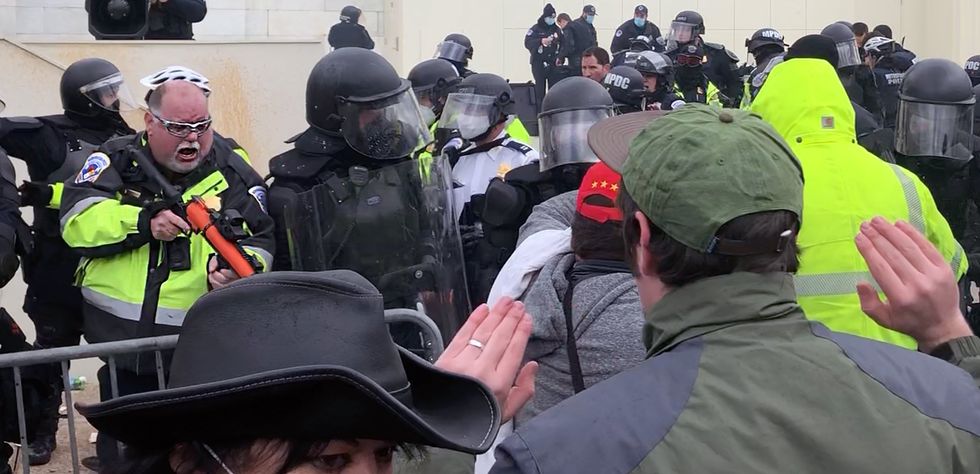 Sgt. Frank Edwards aims his 40mm munition launcher at protesters along the police line on the West Plaza of the U.S. Capitol on Jan. 6, 2021.U.S. Department of Justice
Sgt. Frank Edwards aims his 40mm munition launcher at protesters along the police line on the West Plaza of the U.S. Capitol on Jan. 6, 2021.U.S. Department of Justice
Griffin told him, “We’re not going to hurt anyone,” and Edwards replied, “Then don’t push the fence! Stop pushing the fence!”
Griffin had not touched the bike racks, much less pushed them, video showed.
“I’m just standing there talking to the cops,” Griffin said.
Shortly before Edwards appeared, Griffin said he was struck in the foot by a .60-caliber plastic pellet fired from another officer’s munition launcher. He picked up the projectile and showed it to the officers.
“I said, ‘Officer, officer, please don’t do that,’” Griffin said. “‘They’re all going to panic.’ That was what I told them.”
'We have all kinds of questions about the election.'
After Edwards began shouting at the crowd, Griffin held up the plastic pellet that struck his foot and tried to talk to Edwards. The officer was not interested. “Stop pushing the fence!” Edwards repeated, followed by a near scream, “Stop [unintelligible] the fence!”
“Calm down,” Griffin said, then pitched the pellet forward to the ground near the police line. Almost immediately, Edwards appeared to aim his weapon at Griffin’s legs and fired. “What are you doing?” Edwards shouted, according to his bodycam video. Edwards quickly turned and left the police line, while Griffin nearly collapsed in pain. Video shows him hobbling away from the bike racks and nearly falling. A bystander helped to steady him.
Griffin said he is frustrated at how security video, bodycam footage, and even protester-created video seized by the FBI were covered up for years. It was only after Congress began publicly posting Capitol Police CCTV and media outlets had obtained a critical mass of bodycam video that a visual investigation started filling in the blanks.
“The whole thing with all this stuff, which nobody talks about, is they suppressed the evidence for three years. They didn’t release anything. You couldn’t get any information. And even if I had been hot to go sue somebody the day after this happened, who was I going to sue? I had no way of finding out who even did it.”
Griffin’s case raises a long-simmering issue about police use of force at the Capitol on Jan. 6. Bodycam video shows officers numerous times shooting munitions at protesters who stood mere feet away.
Protesters reported being burned in the legs, face, and hair by exploding flash-bang grenades.
The firing of 40mm munitions likely by Edwards and Glover from point-blank range was “improper and excessive,” according to Karen Laser-Garrett, a former police SWAT commander in Oceanside, Calif., who runs a consultancy specializing in law-enforcement practices.
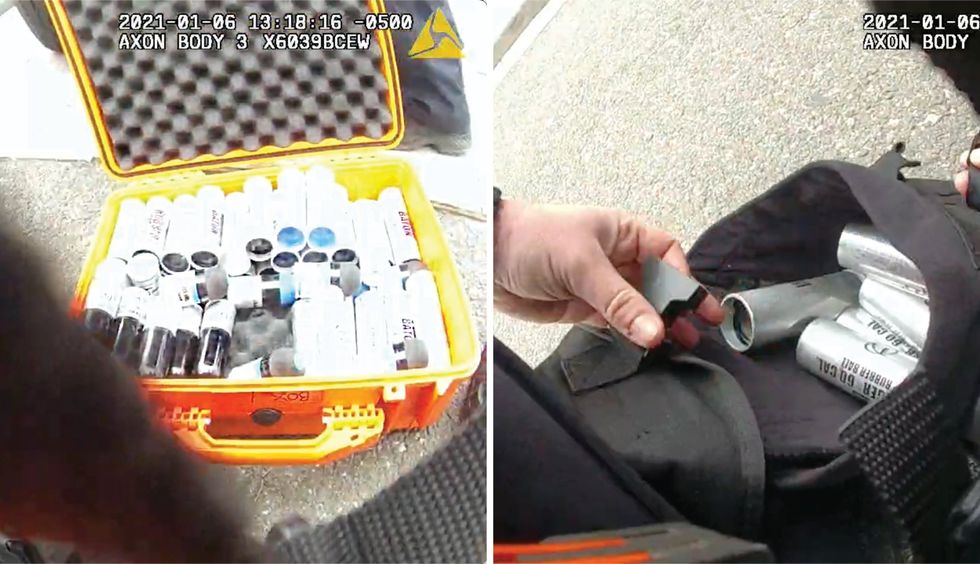 Metropolitan Police Department Officer Tara Tindall fills a shoulder bag with crowd-control munitions at the U.S. Capitol at 1:18 p.m. Jan. 6, 2021.Metropolitan Police Department
Metropolitan Police Department Officer Tara Tindall fills a shoulder bag with crowd-control munitions at the U.S. Capitol at 1:18 p.m. Jan. 6, 2021.Metropolitan Police Department
“Kinetic energy projectiles (40mm) are to be used with the frequency, intensity, and in a manner that is proportional to the threat and objectively reasonable,” Laser-Garrett told Blaze News. “Mr. Griffin was not a threat. Not only were the tools utilized improperly, but also against the manufacturer’s recommendations and the officer’s training.
“Indiscriminate firing of the 40mm into the air, as displayed by Sgt. Edwards, is dangerous, as it may strike the head of a subject, causing severe injury or death,” Laser-Garrett said.
Griffin posed no obvious threat to police, since he is seen on bodycam video trying to de-escalate things, said Laser-Garrett, who has worked in law enforcement for 35 years.
“Mr. Griffin was attempting to communicate and de-escalate the situation with the officers. He was not verbally threatening or carrying any visible weapons,” she said. “Mr. Griffin was not resisting any attempt to take him into custody when he was struck with the 40mm. He then collapsed and was sprayed in the face with a chemical irritant. To what end?”
Stan Kephart, a policing and use-of-force expert who has testified in court more than 350 times during his 40-plus year career, said what happened to Griffin is “clear and convincing evidence” that fails a four-prong test on use of force.
The weapon discharge was not needed because the line was not being breached at the time, he said. The force used was “grossly disparate and excessive.” The injury inflicted was potentially life-threatening, he said. Lastly, the force used was “malicious and sadistic, not used in good faith,” Kephart said.
'We’ve deployed about 500 already.'
Edwards told a colleague as of about 4 p.m. on Jan. 6, MPD went through 500 munition rounds at the Capitol. Many of those salvos were fired into the massive crowd on the West Plaza beneath the inauguration stage.
Some of the munitions exploded at head and chest level, creating a risk of serious injuries or fatalities. Each explosion that sprayed 0.60-caliber pellets across the crowd or released clouds of tear gas only enraged protesters.
These “less lethal” weapons not only did not cause the crowd to disperse, they played a significant role in the eventual collapse of the police line, video showed.
The tear gas swirled in the 30-mph winds and often blew back into the faces of police officers, who were left gasping for air. Heavy use of high-velocity pepper-spray tanks often had a similar result, with over-spray blown back that coated the faces of officers, most of whom did not have gas masks. This was made worse by rioters and agitators at the police line who fired potent bear spray at police.
“We’ve deployed about 500 already,” Sgt. Edwards told a fellow officer. “The wind f**ked us.” He warned another officer, “Watch the wind if you’re throwing munitions 'cause we all got gassed like a motherf**ker.”
According to his bodycam video, minutes later Edwards told another police grenadier, “We got the s**t kicked out of us. We deployed everything. … We ran out. Two trucks ran out.”
Civil rights concerns
Civil rights groups says these types of munitions are often indiscriminate when they explode in a crowd. Groups have called for tighter regulations and state laws to force investigations of every use of crowd-control force that results in injury or death.
“Stun grenades are — as explosive devices — by nature indiscriminate,” according to “Lethal in Disguise,” a report of the International Network of Civil Liberties Organizations and Physicians for Human Rights. “When they are used either as distraction devices to facilitate entry or as a means of crowd dispersal, the limited control users have over their placement may expose unintended targets to the risk of serious injury.
“When used indoors or in dense crowds, these risks are amplified, and stun grenades can also create hazards through fires, as well as the psychological panic they may provoke,” the report said.
Crowd-control weapons don’t tend to achieve the goals of dispersing crowds, the report said.
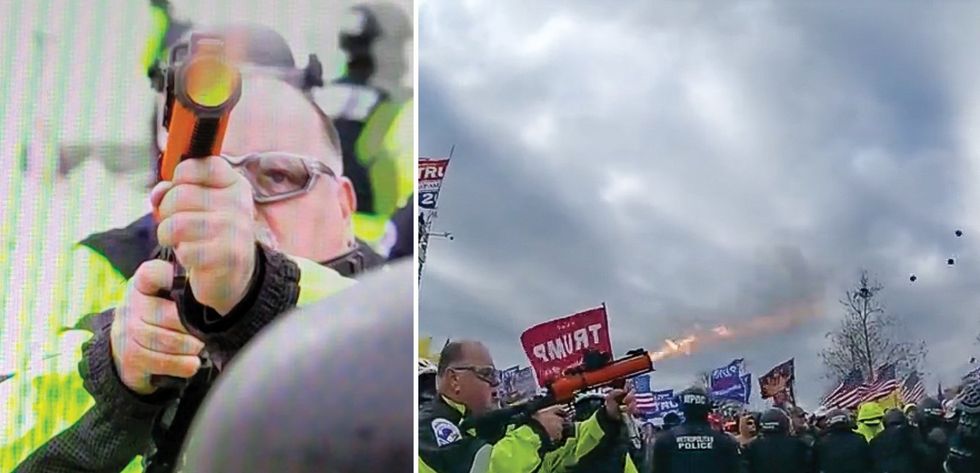 MPD Sgt. Frank Edwards fires crowd-control munitions into the packed West Plaza crowd at the U.S. Capitol on Jan. 6, 2021.U.S. Department of Justice / Metropolitan Police Department
MPD Sgt. Frank Edwards fires crowd-control munitions into the packed West Plaza crowd at the U.S. Capitol on Jan. 6, 2021.U.S. Department of Justice / Metropolitan Police Department
“Upon detonation, distraction devices may — unintentionally or by design — disperse dozens of metal or plastic shards as shrapnel in a spherical radius without any control over what is hit,” the report said. “These weapons are therefore fundamentally indiscriminate impact weapons when used in the context of crowd control.”
A study in BMJ Open (formerly the British Medical Journal) said in the cohort research studies reviewed, 15% of those injured by kinetic impact projectiles had permanent disabilities.
“We find that these projectiles have caused significant morbidity and mortality during the past 27 years, much of it from penetrative injuries and head, neck, and torso trauma,” wrote Rohini J. Haar, M.D., of the University of California-Berkeley and four co-authors. “Given their inherent inaccuracy, potential for misuse and associated health consequences of severe injury, disability, and death, KIPs do not appear to be appropriate weapons for use in crowd-control settings.”
Haar and her associates reviewed research literature from 3,228 sources, eventually settling on 26 that met the study criteria. Those articles gathered injury data on 1,984 people harmed by KIPs between 1990 and 2017.
Fifty-three of the injured died from their wounds, and 300 people suffered permanent disability, the study said. Deaths and disability “often resulted from strikes to the head and neck.” Penetrating injuries caused 56% of the deaths.
 Above: Joshua Black bleeds after being shot in the left cheek with a police projectile. Below: As word of Black’s injury spread, fighting broke out at the police line. Capitol Police responded by firing pepper balls.Special to Blaze News
Above: Joshua Black bleeds after being shot in the left cheek with a police projectile. Below: As word of Black’s injury spread, fighting broke out at the police line. Capitol Police responded by firing pepper balls.Special to Blaze News
Of the 2,135 injuries reported from the 1,984 victims, 71% were severe. Injuries to skin and the extremities were most common. Almost all — 91.5% — of head and neck, ocular, nervous, cardiovascular, pulmonary and thoracic, abdominal, and urogenital injuries were severe, the study said.
While manufacturers provide guidelines on safe distances from which to fire munitions, the study said many of the injured were fired on from much closer.
'You come here, you’re going to get it!'
“Exact distance was impossible to assess in most cases, but forensics and case data suggested that the firing distances were less than those recommended by manufacturers,” the study said.
The authors concluded that crowd-control weapons were ineffective at dispersing protest crowds or groups of rioters.
“To prevent severe injury, most protocols for the use of KIPs instruct law enforcement to use the weapons from a ‘safe distance’ and to aim at soft musculature of the lower limbs,” the study said. “Safe shooting distances are not well validated, however, and are highly variable among weapons, countries, and manufacturers. In practice, deployment of KIPs may occur from distances much closer than deemed safe.”
A study from the University of Texas at Austin said the lower muzzle velocity of crowd-control weapons compared to firearms does not necessarily equate to safe usage.
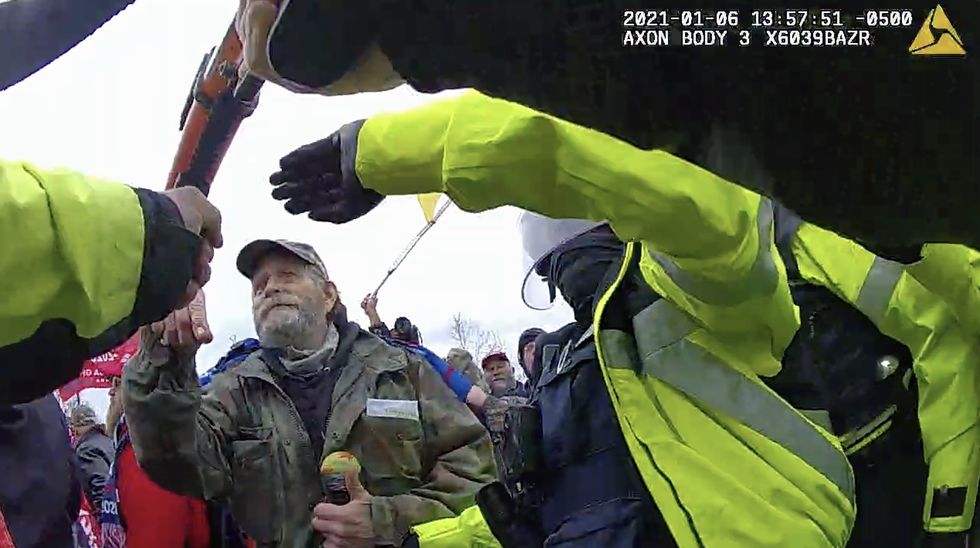 Metropolitan Police Department
Metropolitan Police Department
“While KIPs have a significantly lower muzzle velocity and thereby may be expected to decrease risk of serious injury, recent reports of injuries from KIPs include neurosurgical emergencies, blunt trauma to the chest, penetrating ocular trauma, and testicular rupture,” reported Sanjana Ravi from Dell Medical School at the University of Texas and four study co-authors.
The muzzle velocity of a rubber bullet ranges from 394 to 459 feet per second, the study said. A beanbag round has a muzzle velocity of 295 fps. By comparison, a 9mm bullet has a velocity of 1,155 fps, while a Remington 0.30-30 rifle’s velocity is 2,390 fps.
'Mr. Griffin was not a threat.'
One of the victims in the study came to the emergency room with a beanbag round embedded in her cheek. Removal of the beanbag left a gaping hole in her right cheek. The injury caused facial nerve damage that healed after eight months.
Another patient cited in the study was struck below the left eye by a rubber bullet, causing nasal and jaw fractures. He required surgery to graft bone to the area with a titanium-reinforced implant to reconstruct the orbital floor, the study said.
Police chiefs release guidance
The International Association of Chiefs of Police, a 34,000-member organization based in Alexandria, Va., warned police grenadiers in a 2023 paper, “Impact projectiles cannot be used against a crowd indiscriminately and can be used only in response to an identified act of violence.”
The IACP developed a model policy on crowd control in 2019 to “establish guidelines for managing crowds, protecting individual rights, and preserving the peace during demonstrations and civil disturbances.”
Police should consider alternatives to impact projectiles for those who are only passively resisting, pregnant, elderly, frail, or children, the IACP said.
Only officers who are trained in the use of crowd-control weapons should use them — with each officer required to re-qualify every two years, the paper said. Supervisors should receive advanced training.
Officers need to lend aid if the weapon discharge causes injury to the crowd member, the report said.
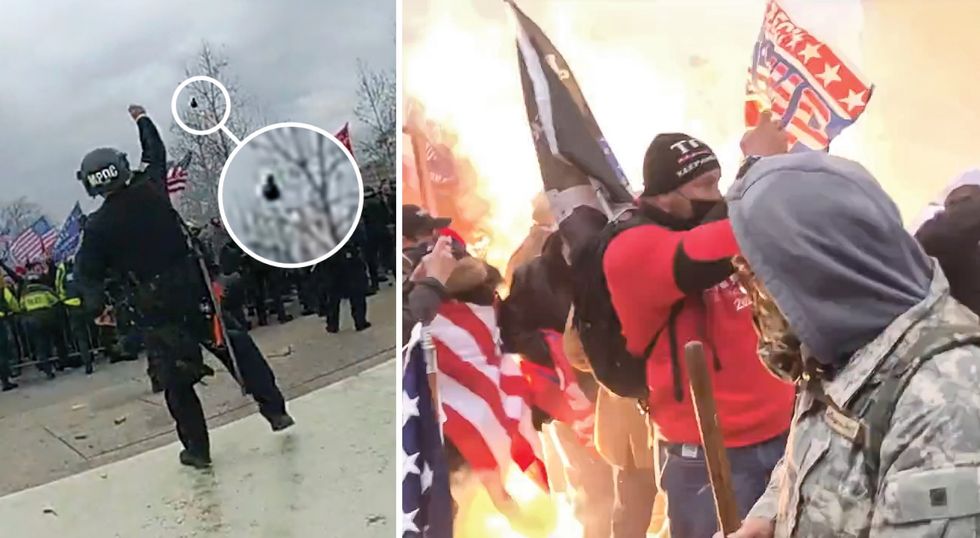 Metropolitan Police Department Inspector Robert Glover lobs a grenade (left) while protesters react to a fiery explosion in the massive crowd on the West Plaza at the U.S. Capitol on Jan. 6, 2021.Metropolitan Police Department/Steve Baker, Blaze News
Metropolitan Police Department Inspector Robert Glover lobs a grenade (left) while protesters react to a fiery explosion in the massive crowd on the West Plaza at the U.S. Capitol on Jan. 6, 2021.Metropolitan Police Department/Steve Baker, Blaze News
“Although impact projectiles are designed to reduce the potential for death or serious physical injuries, protective measures are still necessary,” the paper said. “Thus, as soon as the subject has been satisfactorily subdued, the officer must take immediate steps to care for the subject and account for the force used. When applicable, appropriate medical personnel should be summoned for treatment and/or evaluation.”
Each discharge of an impact projectile must be reported as a use of force, the IACP said.
“A use of force review shall be conducted in any situation involving the discharge of an impact projectile,” the paper said. “The depth of any investigation shall be determined by designated departmental authorities based on the extent of suspect injuries and a review of the circumstances surrounding the incident.”
Blaze News filed a Freedom of Information Act request with MPD for a record of all Jan. 6 use-of-force complaints. The department returned a spreadsheet listing a single complaint having to do with “shoving.” Jacqueline Hazzan, legal counsel for the MPD Office of Police Complaints, said the details of that complaint would not be released because they would “reveal information about the agency’s internal deliberative process before it was completed” and “cause an unwarranted invasion of others’ personal privacy.”
'You’re on camera the whole time! Lie again on camera!'
The department’s 2001 report on use of force has more detail about Jan. 6. According to that report, issued in mid-2022, the Use of Force Review Board made 38 decisions on five use-of-force incidents from Jan. 6. Thirty-six of those were deemed justified and two were not justified. Both non-justified incidents involved use of riot batons.
The review board made 29 determinations regarding the Civil Disturbance Unit’s uses of force on Jan. 6. All were deemed justified. Five of those involved use of oleoresin capsicum (pepper spray), one was a “tactical takedown,” and the rest were for a combination of mechanical force, physical force, and OC spray. Two uses of a taser were deemed justified, the report said.
No mention is made in the report of crowd-control munitions being fired directly at protesters.
On May 11, 2025, Blaze News filed a FOIA request for all officer-produced Use of Force Incident Reports for Jan. 6. The request was assigned to a FOIA officer, but the department has not yet responded with documents responsive to the request.
Blaze News asked MPD multiple times over weeks to comment on Sgt. Edwards’ use of force against Griffin and whether it comports to the department’s force policy, but did not receive a reply.
Issue is complex for police
An MPD officer who was among the hundreds stationed along the police line on the West Plaza told Blaze News there was a lot more to the crowd dynamics than is evident on bodycam footage. He was not involved in or aware of the Griffin use-of-force incident. Officers were worried about what would happen if the huge crowd plowed through the police line, he said.
“If they broke through the middle, my other fear is we’re going to get the f**k beat out of us because this crowd we’ve been fighting that’s just getting worked up has now gotten the upper hand, and we’re done,” said the officer, speaking on the condition of anonymity.
“I mean, I hate to be an alarmist, but there was some fear for my life on some points of that, where I’m like, ‘I don’t think this is going to work out well, guys.’ I’m not saying I’m going to die, but this could be the end.”
The officer said he never before came upon a protest or riot scene where defeat seemed assured.
“From before I even went down the steps, when I went onto the upper platform of the Upper West Terrace, I said, ‘Oh s**t, I think we’re going to lose.’”
 Police on the West Plaza were shellacked by rioters with projectiles — from a fire extinguisher to metal tines from a decorative fence, one of which drew blood from the officer at right.Metropolitan Police Department
Police on the West Plaza were shellacked by rioters with projectiles — from a fire extinguisher to metal tines from a decorative fence, one of which drew blood from the officer at right.Metropolitan Police Department
It’s too easy to misread situations based on someone’s video analysis, he suggested.
“Everyone’s blinded by the bulls**t,” he said. “Dissecting body-camera footage and finding a street cop saying something stupid isn’t going to change the narrative of January 6. Great, you embarrassed somebody. That doesn’t change it.
“Even if he said some really heinous stuff or one guy’s actions, that didn’t start this,” the officer said. “What we need to think about is how did we get here with such lax security, and what brought that angry element to the front? That’s what needs to be discussed.”
While there is no evidence Griffin did anything more than talk to police, plenty of others in the massive crowd turned to rioting.
One man whipped an iron tine from the West Plaza decorative fence that was torn down by rioters. The three- to four-foot hollow metal rod sailed into the crowd of police like a javelin, striking an MPD officer directly between the eyes. He collapsed, bleeding profusely on the concrete before fellow officers hurried him away.
Rioters threw water bottles, megaphones, pieces of fence, pieces of furniture, smoke bombs, a fire extinguisher — different from the false report that Capitol Police Officer Brian Sicknick had been “bludgeoned” with a fire extinguisher — pieces of lumber, garbage cans, and flagpoles. Numerous rioters sneaked from hidden positions in the crowd to blast police officers in the face with potent, orange-color bear spray.
Focusing on bodycam footage too much or finding video that shows an officer uttering off-color remarks does not make for an accurate report of Jan. 6, the officer said.
'It isn't right.'
One example of that on Edwards’ bodycam was a remark he made about a protester on the Upper West Terrace at 4:50 p.m. Officer Tara Tindall pointed at someone off camera. “That man,” she said, to which Edwards replied, “I want to spray him so bad.” Tindall’s rejoinder: “Tase him.”
About 20 minutes later, Edwards bellowed at a protester who had fallen down the concrete steps below the Lower West Terrace Tunnel. Another officer grabbed hard on the woman’s elbow, then pulled her toward him, video showed. She tripped and tumbled. When she blamed the officer for pushing her, Edwards let her have it.
“Somebody help me!” the woman said, lying in an awkward position and visibly in pain.
“Don’t worry about it,” Edwards said. “Stay there, and we’ll get you medical.”
The other officer “pushed me down the steps,” she said, in tears. “I can’t move my back.”
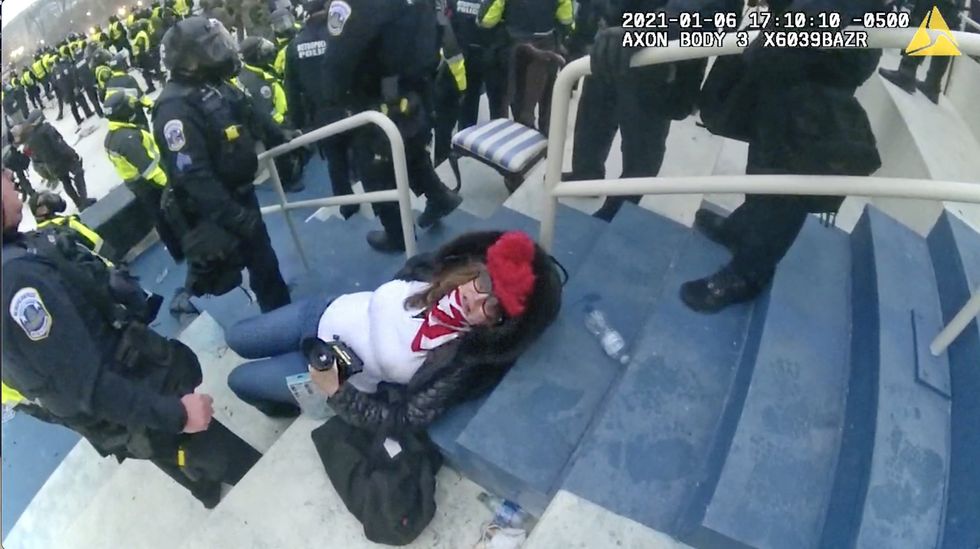 A woman who was grabbed roughly by a Metropolitan Police Department officer tumbled down the stairs and injured her back. When she accused the officer of pushing her, MPD Sgt. Frank Edwards called her a liar.Metropolitan Police Department
A woman who was grabbed roughly by a Metropolitan Police Department officer tumbled down the stairs and injured her back. When she accused the officer of pushing her, MPD Sgt. Frank Edwards called her a liar.Metropolitan Police Department
“You’re on body-worn camera right here,” Edwards shouted. “Nothing happened like that. The camera’s right here. Say it again! ... Say it!
“Say it! You’re on camera the whole time! Lie again on camera. Then say what you just said!”
“You didn’t see it,” the woman told Edwards.
“It’s on camera! You’re on camera from when you broke into the [Capitol] office. You might get charged with a felony!”
“I don’t care,” the woman cried, prompting Edwards to reply, “OK, good!”
Edwards walked away toward the tunnel entrance. When he saw Virginia State Police tactical officers stop to help the woman at 5:13 p.m., Edwards shouted, “We’ve got medical coming for her.”
The Virginia police medics were still tending to the woman at 5:16 p.m. when Edwards’ bodycam cut off.
Griffin hopes for justice
Griffin said he suspects most people who were injured by police force on Jan. 6 stayed quiet for fear of being arrested by the FBI and subjected to heavy-handed prosecution by the Biden DOJ. He hopes they will come forward now that the Jan. 6 indictment machine has been shut down.
Judge Howell criticized Griffin and his attorney for not more quickly moving to use the legal discovery process to identify the officers listed in the suit as John Does. Griffin’s attorney withdrew from the case in March, so Griffin is looking for new legal help to appeal Howell’s order and continue his suit.
“I just don’t know if I could get another lawyer that would appeal this thing pro bono,” Griffin said. “I mean, because I don’t have a hundred thousand dollars in the bank to throw at this.”
Griffin hopes he hasn’t run out of options. He worries there will be no accountability for the shooting.
As for justice?
“I’d like to see it happen,” Griffin said. “It’s just not right to let them get away with that. It isn’t right.”
Like Blaze News? Bypass the censors, sign up for our newsletters, and get stories like this direct to your inbox. Sign up here!
Source link

